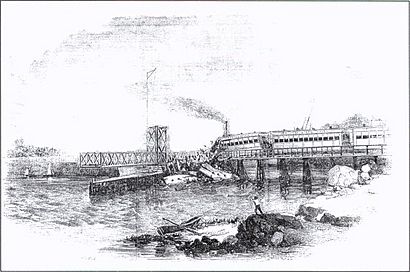Norwalk rail accident facts for kids
Quick facts for kids Norwalk rail accident |
|
|---|---|

Originally entitled 'The Catastrophe' the illustration depicts the accident site
|
|
| Details | |
| Date | May 6, 1853 |
| Location | Norwalk, Connecticut |
| Country | United States |
| Line | New York and New Haven Railroad |
| Incident type | Draw (swing) bridge open |
| Cause | Signal passed at danger |
| Statistics | |
| Trains | 1 |
| Passengers | 200 |
| Deaths | 48 |
| Injured | 30 |
The Norwalk rail accident happened on May 6, 1853, in Norwalk, Connecticut. It was the first big train disaster involving a bridge in the United States. A train carrying about 200 passengers was going fast when it plunged into the Norwalk Harbor. This happened because a drawbridge was open. Forty-eight people died in this terrible event.
Contents
What Happened at Norwalk
The accident took place on the New York and New Haven Railroad line. This line crossed a small part of Long Island Sound using a special bridge. This bridge was a swing bridge, meaning it could open up to let ships pass through.
The Warning Signal
Trains coming from New York approached the bridge around a sharp curve. To warn train drivers if the bridge was open or closed, there was a signal. This signal was a red ball placed high up on a tall pole. If the red ball was visible, it meant the bridge was open and not safe for trains to cross.
The Train Journey
On the morning of May 6, 1853, at 8:00 AM, a train called the Boston express left New York. It had about 200 passengers on board. The train was driven by a substitute driver. This was only his third time driving on this route. The train had two baggage cars and five passenger cars.
The Crash
As the train got close to the bridge, the driver did not check the warning signal. He only realized the bridge was open when the train was about 400 feet away from it. The bridge had just opened to let a steamship called the Pacific pass through.
The driver quickly tried to stop the train. He put on the brakes and reversed the engine. But it was too late. He and the fireman jumped off the train before it reached the bridge. They were not seriously hurt.
The train's engine flew across the 60-foot gap where the bridge should have been. It hit the other side of the bridge opening about 8 feet below the tracks. Then, it sank into 12 feet of water.
The Aftermath
The baggage cars crashed on top of the sunken engine. The front of the first passenger car was crushed against the baggage cars. It then went underwater as the second passenger car piled on top of it. The third passenger car broke in half. The front part hung over the edge of the bridge opening. The back part stayed on the tracks.
Most of the 48 people who died and the 30 people who were injured were in that first passenger car. Eight more people were reported missing after the accident.
Many doctors were on the train that day. They were returning from a big meeting in New York. Seven of these doctors died in the crash. One doctor who was not hurt was Dr. Gurdon Wadsworth Russell. He wrote about the accident for a newspaper called the Hartford Courant. He said that the people who died "presented all the symptoms of asphyxia from drowning." This means they likely drowned very quickly, trapped by the broken train cars. He called it "Oh, what a melancholy scene that!"
Changes After the Accident
The Norwalk rail accident caused a lot of shock and anger among the public. Because of this, the Connecticut Legislature (the state's law-making body) passed a new law. This law said that every train in Connecticut had to stop completely before crossing any bridge that could open.
The train engineer was blamed for the disaster. He was held responsible for not paying attention to the signal.
A similar train accident happened eleven years later in Canada. That one, called the St-Hilaire train disaster, had even more people die.

